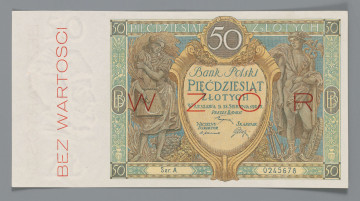
10 zlotys – a template
1919
National Museum in Lublin
Part of the collection: Paper money during the Second Polish Republic
The end of World War I and the regaining of independence after one hundred and twenty-three years of bondage understandably aroused patriotic feelings among all strata of Polish society. This was also reflected in the choice of name for the reborn state, as indicated by the names proposed at the time – ‘lech’, ‘sarmat’, ‘piast’ or ‘polon’. Ultimately, the most historically motivated name – zloty – prevailed, which was reflected in the text of the Sejm Act on the Name of the Polish Coin of 28 February 1919. In the same year, steps were taken to establish a new issuing institution, which was to become Bank Polski. It was to replace the Polish National Loan Fund, which had been established on the initiative of the German authorities on 5th December 1916. One of the steps leading up to this was the creation of a national treasury fund, which was to constitute the Bank's share capital. Another was the issue of the first gold banknotes of the reborn Poland. On these banknotes the name Bank Polski appeared as the issuer, but in fact it was established much later. It was not until 1924 that the deteriorating economic situation forced the authorities to take radical action. One of them was a currency reform introducing the zloty currency into circulation in place of the hitherto circulating Polish mark. This was the implementation, after more than five years, of the postulates of February 1919. Only then were the banknotes, which had been waiting in boxes for five years, put into circulation. One of them was the fifty-zloty banknote. Like other banknotes of lower denominations, it was designed in France by unknown graphic artists from the studio of professor Egène Gaspé. Its obverse bore an image of Tadeusz Kościuszko, as did almost all the other denominations. The only exception was a five-zloty banknote with an image of General Józef Poniatowski. A distinctive feature of the 50-zloty banknote, like the 20-zloty banknote, was the sequence of signatures of the employees of the management of the Bank of Poland. In these cases, Zygmunt Chamiec's signature was on the left and Stanisław Karpiński's on the right. On the other denominations it was the other way around. The 50-zloty banknotes were printed in an edition of 2,872,460 pieces.
Leszek Poniewozik
Author / creator
Dimensions
cały obiekt: height: 164 mm, width: 102 mm
Object type
paper money
Technique
Material
paper
Creation time / dating
Creation / finding place
Owner
The National Museum in Lublin
Identification number
Location / status

1919
National Museum in Lublin

1923
National Museum in Lublin

1925
National Museum in Lublin
DISCOVER this TOPIC
Castle Museum in Łańcut
DISCOVER this PATH
Educational path